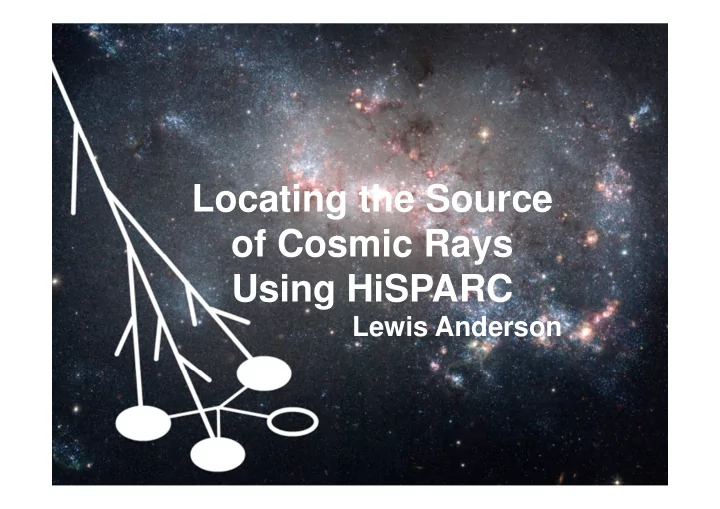

Locating the Source of Cosmic Rays Using HiSPARC Lewis Anderson
Presentation Index • Introduction to Cosmic Rays • The HiSPARC Experiment • Methods and Results • Conclusions • Acknowledgements
Cosmic Rays • Fast moving particles • Protons (85%), alpha particles (12%) and electrons (2%) • Range of energies, f rom 10 9 eV to 10 20 eV • Unknown sources • Cause air showers
The HiSPARC Experiment • High School Project on Astrophysics Research with Cosmics • Recording data since 2002 • Set up in “clusters” – Bristol, Amsterdam & Birmingham
Locations of HiSPARC Detectors
HiSPARC Detectors • Detectors stations of roofs of schools and academic institutes. • Two scintillator plates detect Muons • Data sent to central database in Nikhef
Calculating Angle of Cosmic ray Excess • Event data taken from HiSPARC public database. • 3 consecutive weeks, 27 detectors. • Calculated angle for times throughout observation period. • Weighted data and x-y components calculated using Fourier transformation. • Found direction of source and calculated Right Ascension. • Calculated percentage deviation.
Calculating Angle of Cosmic ray Excess
Calculating Angle of Cosmic ray Excess
Results 12 10 Number of Detectors Week Beginning 8 26th May 2014 6 Week Beginning 2nd May 2014 4 Week Beginning 2 9th May 2014 0 0-60 60-120 120-180 180-240 240-300 300-360 Right Ascension /degrees Two different statistically significant peaks.
Triangulation of Primary Particle Direction • Science park cluster. • Individual coincidence data for events detected by 6 or more detectors over 4 days. • Relative positions and detection times for first 3 detectors found. 40 20 0 y / metres 0 20 40 60 80 100 120 -20 -40 -60 -80 -100 -120 x / metres Stations 503, 506, 507
Triangulation of Primary Particle Direction • Azimuth and Zenith angles for primary particle calculated. • Used to Calculate right ascension and declination.
Results Uniform distribution of right ascensions 120 100 80 Declination//degrees 60 40 20 0 0 50 100 150 200 250 300 350 400 -20 -40 Right Ascension/degrees
Conclusions • First method found angular dependence for 2 of 3 weeks. • Could not find source at those positions. • Found no angular variation for second method. • Improvements could be made to method and become more effective as HiSPARC network grows.
Acknowledgements • Dr Maria Pavlidou • Dr Cristina Lazzeroni • Dr Ilya Mandel • Dr Laura Vickers • University of Birmingham
Any Questions?
Recommend
More recommend